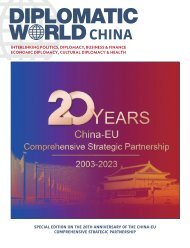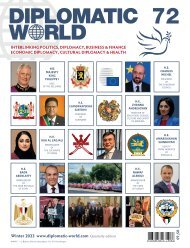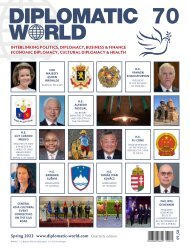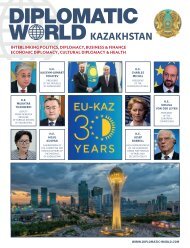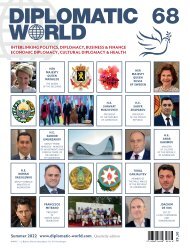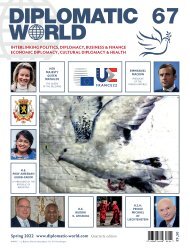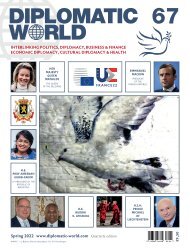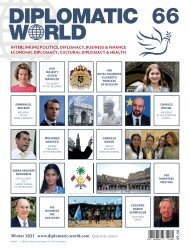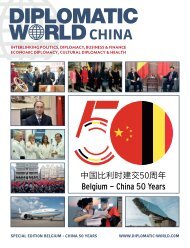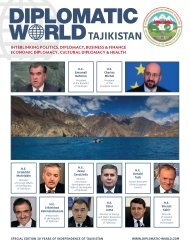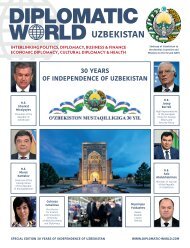Diplomatic World_69
You also want an ePaper? Increase the reach of your titles
YUMPU automatically turns print PDFs into web optimized ePapers that Google loves.
THE AFRICAN CONTINENT<br />
IN THE 21 ST CENTURY<br />
Ameenah Gurib-Fakim<br />
Former President of the Republic of Mauritius<br />
The African continent is 30 million square km large, representing<br />
20 percent of the Earth’s surface, and much of it is covered by<br />
forests or underlain by vast million reserves. She is home to<br />
1.3 billion people, 17 percent of the global population, and her<br />
population is projected to reach 2.53 billion by 2050.<br />
Yet the continent produces only 3 percent of global GDP,<br />
accounts for less than 3 percent of global trade (most of which<br />
is dominated by primary commodities and natural resources),<br />
shoulders 25 percent of the global disease burden, and accounts<br />
for only 2 percent of world research output, 1.3 percent of research<br />
spending, and 0.1 percent of patents.<br />
How can a continent with the largest share of the world’s remaining<br />
arable land (60 percent); a continent with the youngest<br />
population a continent that has fuelled all of the world’s industrial<br />
revolutions; a continent that has helped drive the mobile phone<br />
industry; a continent that is at the cusp of supporting the world’s<br />
energy transition to greener technologies with her large store of<br />
rare earth mineral deposits accept such dismal statistics?<br />
a development objective that has eluded Africa for decades - in<br />
the AfCFTA era hinges on Africa closing its scientific and technological<br />
gap with the rest of the world and sustainably producing<br />
the right set of skills to address supply-side constraints and<br />
ultimately expand both extra- and intra-African trade and sustain<br />
higher rates of growth to accelerate the process of global income<br />
convergence.<br />
There’s a proverb that says: “The best time to plant a tree was<br />
20 years ago. The second-best time is now”. We can bring many<br />
seedlings and shovels … and plant many trees that will flower<br />
together, nurtured by the best scientific knowledge available and<br />
the talents of Africans.<br />
It can be done. As responsible stewards of our beloved continent<br />
it must be done so that the benefits of science, technology and<br />
innovation are marshalled for greater economic, social and environmental<br />
sustainability both on the continent and beyond.<br />
Our challenges are fundamental and structural. A deficit of<br />
investment in science and technology and a lack of economic<br />
and scientific infrastructure for innovation have undermined the<br />
process of economic transformation both at the structural level -<br />
the shift of workers and resources from low to higher productivity<br />
sectors – and at the sectoral level—the growth of productivity<br />
within sectors.<br />
This is where investment in the human capital; empowerment<br />
and inclusion of women; the nurturing of fledging entrepreneur;<br />
promotion of innovative practices; reinforcing intra African trade<br />
and manufacturing will make a big difference.<br />
The recent ratification of the African Continental Free Trade<br />
Agreement (AfCFTA), has huge potential as it de-fragments<br />
Africa to establish the largest single market in the world by<br />
membership and create the conditions for scale, also removes<br />
one of the most important obstacles on the path of economic<br />
transformation.<br />
But meeting the challenge of economic transformation -<br />
Ameenah Gurib-Fakim, Former President of the Republic of Mauritius and<br />
Barbara Dietrich, <strong>Diplomatic</strong> <strong>World</strong><br />
11





